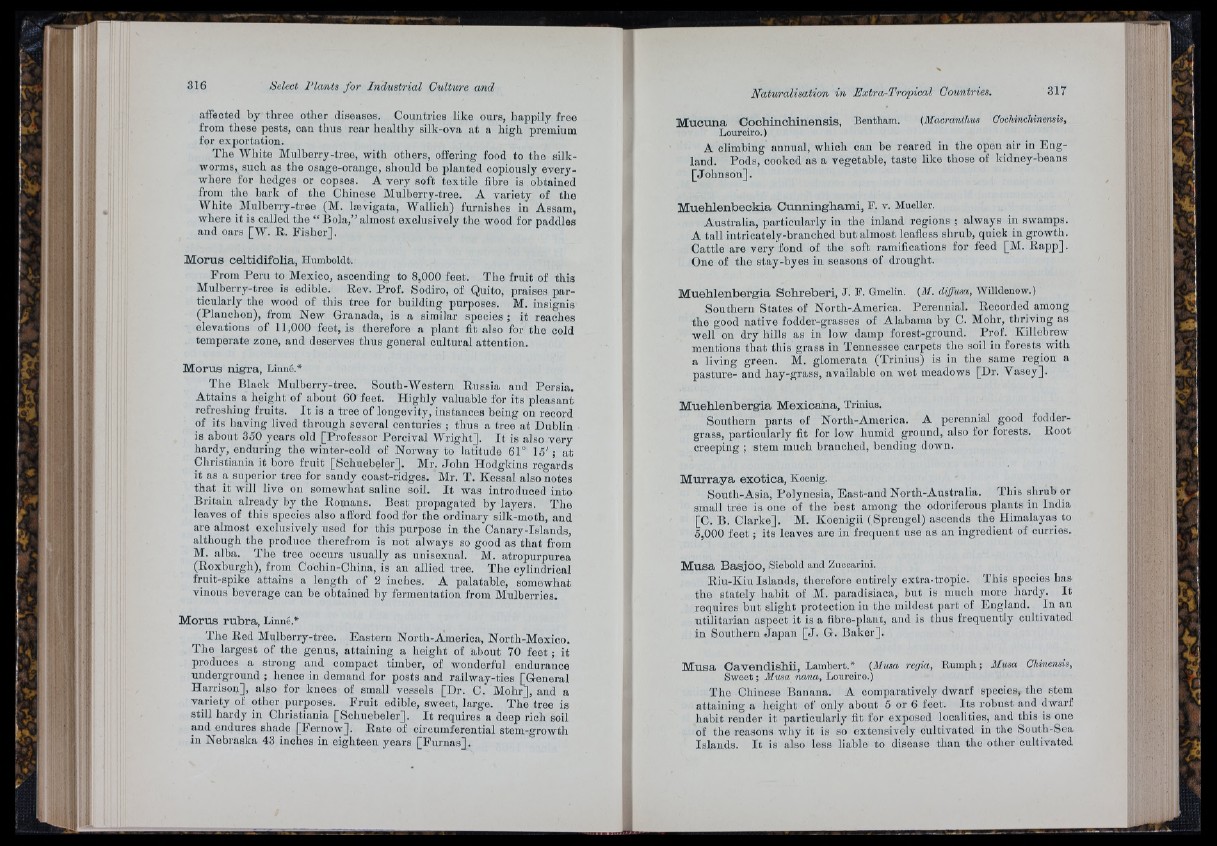
i f u |7
Select Plants fo r Industrial Culture and
affected by tlireo other diseases. Coiiiitrios like ours, iiappily froo
from tliose posts, can tlms rear liealtliy silk-ova at a liigli premium
for exportation.
Tho Wliito Miilberry-treo, with others, offering food to tho silkworms,
such as tlie osago-orauge, should bo planted copiously evory-
wliore for bodges or copses. A vory soft toxtilo fibro is obtained
from tlio bark of the Cliinose Mulborry-tree. A variety of the
Whito Mulhorry-tree (M. lævigata, Wallicli) furnishes in Assam,
where it is callod tlio “ Bola,” almost exclusively the wood for paddles
and oars [W. R. Fisher].
M o r u s c e ltid ifo lia , Humboldt.
From 1‘eru to Mexico, ascending to 8,000 feot. Tlie fruit of this
Mulborry-troo is ediblo. Rev. Prof. Sodiro, of Quito, praises particularly
tho wood of this tree for building purposes. M. insignis
(Planolion), from Now Granada, is a similar spocios ; it reaches
elevations of 11,000 feot, is tlioroforo a plant fit also for the cold
temperate zone, and deserves thus general cultural attention.
M o r u s n ig r a , LimiC.*
Tlio Black Mnlborry-tree. Soutli-Wostern Russia and Persia.
Attains a lioiglit of about 60 feot. lligdily valuable for its pleasant
rofrosliing fruits. I t is a tree of longevity, instances being on record
of its liaving lived tlirough sovoral centuries ; tlms a tree a t Dnlilin
is about 350 yoars old [Professor Porcival Wright], I t is also vory
hardy, oiiduring tlio winter-cold of Norway to latitudo 61° 1 5 '; at
Cliristiania it lioro frnit [Sclmebeler]. Mr. John Hodgkins regards
it as a superior troo for sandy coast-ridgos. Mr. 'T. Kessal also notes
th a t it will livo on somewliat saline soil. I t was introduced into
Britain already by tlio Romans. Best propagated by layers. 'The
loaves of tliis species also afford food for the ordinary silk-moth, aud
aro almost oxcliisively used for this purpose in tho Canary-Islands,
although tlie produce tliorofrom is not always so good as th a t from
M. alba. 'TIio troo occurs usually as unisexual. M. atropurpúrea
(Roxliiirgli), from Cooliin-China, is an allied treo. 'The cylindrical
fruit-spike attains a length of 2 inches. A palatable, somewhat
vinous beverage ean be obtained liy Ibrmontatioii from Mulberries.
M o r u s r u b r a , Linné.*
Tlie Rod Mulberry-tree. Eastern North-Amorioa, Nortli-Mexico.
'The largest of the genus, attaining a lieight of aliout 70 foot ; it
produces a strong and compact timber, of wonderful endurance
underground ; lionco in demand for posts and railway-ties [General
Harrison], also for knees of small vessels [Dr. C. Molir], and a
variety of other jiurposes. Em it edible, sweet, large. 'The tree is
still liardy in Christiania [Schuolieler]. I t requires a deep ricli soil
and endures shade Eornow]. Rato of circumferential stem-growth
in Nebraska 43 iiic los iu eighteen yoars [Fu rn a s].
M u c u n a C o c h in c h in e n s is , Bentham. (Macranlhm OocMncMnensis,
Loureiro.)
A climbing animal, whicli can bo roarod in tho open air in E n g land.
Pods, cookod as a vegetable, taste liko those of kidney-beans
[Johnson].
M u e h l e n b e c k i a C u n n in g h am i, F. v. Mueller.
Australia, particularly in the inland regions ; always in swamps.
A tali intrieately-branehed but almost loailcss shrub, quick in growtli.
Cattle aro very fond of tho soft ramifications for feed [M. Rapp].
Ono of tlio stay-byes in seasons of drouglit.
M u e h l e n b e r g ia S c h r e b e r i, J. F. Gmclin. (M. diffusa, Willdenow.)
Southorn States of Nortli-America. Perennial. Recorded among
tlio good native fodder-grasses of Alabama by C. Mohr, thriving as
woll oil dry hills as in low damp forest-ground. Prof. Killobrew
mentions th a t this grass in 'Tennossoo carpets the soil in forests with
a living green. M. glomerata ('Triuius) is in tlio same region a
pasture- and hay-grass, available on wet meadows [Dr. Vasey].
M u e h l e n b e r g ia M e x ic a n a , 'frinius.
Soutliern parts of North-Ameriea. A perennial good fodder-
grass, particularly fit for low humid ground, also for forests. Root
creeping ; stem mucli branched, bonding down.
M u r r a y a e x o tic a , Koenig.
Soutli-Asia, Polynesia, E a s t - a i i d North-Australia. 'I'his slirub or
small treo is one of tlio best ainong llio odoriferous plants iu India
[C. B. Clarke]. M. Koonigii (Sprengel) ascends tho Himalayas to
5,000 feet ; its leaves aro in frequent use as an ingredient of curries.
M u s a B a s jo o , Siebold and Zuccarini.
Riii-Kiu Islands, tlioroforo entirely extra-tropic. 'Tliis species has
tlio stately liabit of M. paradisiaca, but is mucli nioro hardy. I t
requires but sliglit protection in tlio mildest part of England, in an
utiiitiirian asjioct it is a fibro-plaiit, and is thus frequently cultivated
in Soutliern Japan [J . G. Baker].
M u s a C a v e n d is h ii, Lainbort.* (Musa regia, Rumph; Musa Chinensis,
Swout ; Mma nana, Loureiro.)
'The Cliinese Banana. A comparatively dwarf species, the steni
attaining a lieiglit of only about 5 or 6 foet. Its robust and dwarf
habit render it particularly fit for exposed localities, aud tliis is one
of tlio reasons why it is so oxtonsivoly cultivated in tho Soiitli-Sea
Islands. I t is also less liable to disoaso tlian tlio otlier cultivated
Ih